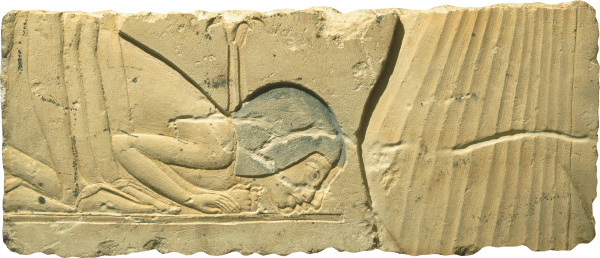Jerusalem’s Glory Restored (60:1–22)
Arise, shine, for your light has come (60:1). While darkness signifies despair, light signifies hope (see comments on 9:2; 42:7). Mesopotamian literature credits light to Enlil (“the life-giving light”1379) and Shamash, the sun god, or to kings (see 10:16). Egypt also credits it to manifestations of the sun god. In the northern Sinai site of Kuntillet ʿAjrud, a Hebrew text, probably from the eighth century, speaks of a day of battle “when God (El) shone forth,”1380 bringing victory (as he does in Isaiah).
To you the riches of the nations will come (60:5). When the Assyrians and Babylonians conquered nations, they exacted tribute that was brought to them, as is described in texts (see comments on 7:1, 6; 13:17; 18:7) and pictured by laden people shown on palace reliefs.1381 Now the tables are turned, with the erstwhile captives now receiving tribute gifts.
Herds of camels . . . young camels (60:6). Camels were part of the tribute brought to Mesopotamian kings. Tiglath-pileser III states: “I received she camels along with their young camels [the same term, bkr, as is used here].”1382 Here they will be returned to Israel, a one-time tribute payer herself.
Incense (60:6). See comments on 1:13; 17:8.

Camels in the Negev
Copyright 1995–2009 Phoenix Data Systems
Kedar . . . Nebaioth (60:7). Inhabited by descendants of Ishmael (Gen. 25:13; 1 Chron. 1:29), the area probably lies in the northwest Arabian peninsula.1383 Kedar (Qedar) and Nebaioth (Nabayatu) are mentioned in Akkadian texts from the Neo-Assyrian and Neo-Babylonian periods.1384 Ashurbanipal mentions both towns in descriptions of his campaigns,1385 and Kedar’s king joined the Persians to attack Egypt during the Persian period.1386
Fly along like . . . doves to their nests (60:8). Doves are among the clean animals used for sacrifice (Lev. 1:14). Here they are a sign of hope and settledness, returning to the window ledges1387 from which they had previously departed. A Sumerian lament from the second millennium sheds light on the importance of this bird. There the dove is symbolic of a deity (cf. Matt. 3:16), whose departure from the temple symbolizes her abandonment of her people: “Like a frightened dove, I spend the day (huddled) against the rafters. . . . The window where I focus attention has been destroyed. Its dove flies away. The dove of the window has abandoned her nest.”1388 What looks like a dove is pictured on an Israelite jar-handle seal.1389
Ships of Tarshish . . . with their silver (60:9). Though the exact location of Tarshish is uncertain,1390 it is also associated with silver in the seventh-century Hebrew Temple of the Lord ostracon: “As Ashyahu the king commanded (you) to give into the hand of Zechariah three sh(eqels) of silver of Tarshish.”1391
Glory of Lebanon (60:13). On Lebanon’s trees, see comment on 2:13.
Pine (60:13). Most likely juniper, this was a fragrant wood used in Mesopotamian building. Sargon roofed his royal palace “with juniper beams and made it smell sweet.”1392 An Egyptian text directed to King Merikare describes a military campaign: “I pacified the entire West as far as the coast of the sea. It pays taxes, it gives cedar wood, one sees juniper wood which they give us.”1393 This reflects the same Isaianic context of tribute.
Bow down at your feet (60:14). A person abasing himself before another often associates himself with that person’s feet. The writer of an Amarna letter describes himself as “[the dust] under the sandals of the king, my lord; I fall at the king’s feet,”1394 while a god approaches two other gods, “his ancestors. He prostrated (himself), kissed the ground before them.”1395 The great gods “kiss the ground” before the goddess Inanna in the Sumerian Exaltation of Inanna.1396

Courtiers kneeling
Werner Forman Archive/Schimmel Collection, New York
You have been forsaken (60:15). Divine abandonment explained the fall of cities or nations. When the deity is with the people, they flourish, but when the god leaves, they fall. Mesopotamian examples begin with third millennium Sumerian texts and continue with second millennium Akkadian ones.1397 Esarhaddon, in a building description, recounts his rebuilding of Babylon, which had been destroyed because of evil within. It was precipitated because “the gods and goddesses, who dwelt therein, went up to heaven,”1398 leaving the city to fend for itself.1399
Abandonment by the Moabite god Kemosh is implied in the Mesha Inscription, since “Omri was the king of Israel, and he oppressed Moab for many days, for Kemosh was angry with his land,”1400 leaving it to its own devices. But abandonment is not permanent, since Kemosh, and Esarhaddon’s gods, return, as does the God of Israel, as the end of this verse indicates.
Nursed at royal breasts (60:16). See comment on 49:23.
The LORD will be your everlasting light (60:19). See comment on 60:1.
I am the LORD (60:22). See comment on 41:13.